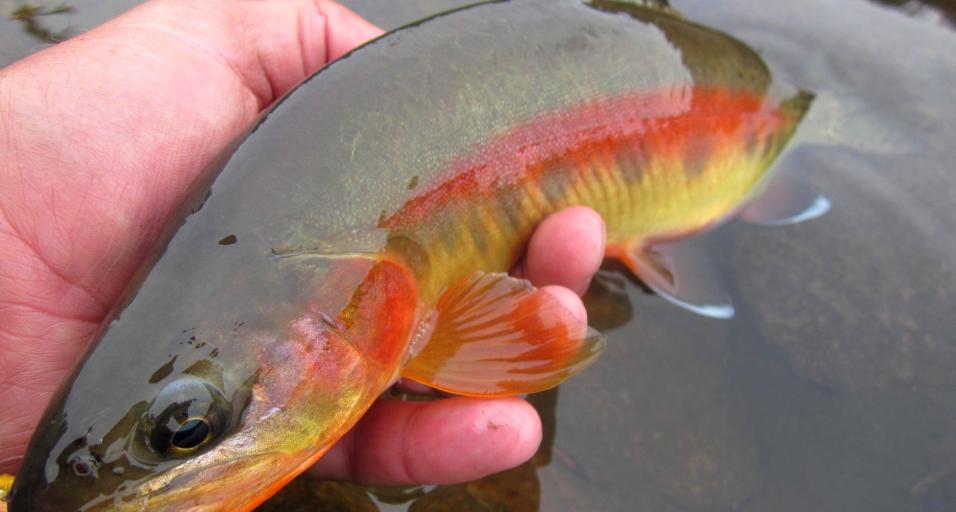The name golden trout conjures up images of pristine, remote, wilderness, spectacular, sore knees and an aching back. After all, to get to where golden trout live, a long arduous journey is often required.
Golden trout are native to the Kern River watershed in California’s Sierra Nevada mountain range, more specifically the Kern Plateau. From Alaska to Mexico, the sea-run coastal rainbow inhabited most mountain streams, including the Kern watershed. Approximately 20,000 to 30,000 years ago, tectonic movement, volcanoes, glaciations, and erosion created the Kern Plateau, but they also created barriers such as waterfalls and hanging valleys (an abrupt change in elevation at a valley’s outlet). Isolated, the sea-run rainbow wasn’t able to be a migrating fish and these isolated rainbow trout in the Kern watershed evolved into the subspecies we know today as the golden trout.
While golden trout are not native to the Cowboy State, they have had a pretty unique history within our borders and other Rocky Mountain states. Golden trout eggs from California were first brought to Cook Lake (Sublette County) in 1920 by U.S. Forest Service personnel. The stocking of eggs continued through 1925 with additional stockings in 1929 and 1932. Once the Cook Lake fishery was established, it served as the brood stock for Wyoming, providing eggs for Wyoming and other Rocky Mountain states from 1936 through 1954. In 1955, Cook Lake was abandoned in favor of Surprise Lake (Sublette County). Surprise Lake was originally stocked in 1949 and was our brood source from 1955 through 1993.
Unlike captive brood stocks, collecting eggs from wild sources like Surprise Lake is often a very difficult task. Personnel and equipment have to be packed in (hiking, horses, or helicopters) several miles. Personnel then have to capture the fish and hold them in pens until they are ready to spawn. All the while camping and living in the wilderness, battling “mother-nature” for several days or weeks.
In 1988, a very large fire (same year as the Yellowstone fire) burned hot and long in the upper Surprise Lake drainage. In the years to follow, golden trout egg collection suffered and was eventually abandoned. The aftermath of the fire contributed heavy sediment and debris loads to the lake and the inlet stream. Natural reproduction decreased significantly and genetic integrity in the remaining population became compromised (i.e., fewer individuals equals less genetic variability).
Other attempts to create a wild brood stock failed at three other waters, in the mid to late 90s due to genetics and logistics. During this time, golden trout were still stocked and the eggs came from Grave Creek Lakes (Fremont County). however, genetic analysis found these fish to be less than 100% pure.
Rather than continue with trying to collect eggs from the wild, a rare opportunity presented itself, albeit, in an unanticipated way. In 2005, a batch of fish at the Story Hatchery tested positive for whirling disease. Whirling disease cannot be transmitted from fish to egg and because of this, Story Hatchery was revamped from a production facility (a facility that grows fish up to size and stocks them out) to a brood stock facility (a facility that spawns the broods and provides eggs to other facilities to raise and stock). Story’s water supply very closely mimics the spawning temperatures and timing of spawning golden trout in the wild. In 2007, golden trout eggs from Sylvan Lake, Montana were shipped to Story and in 2009, the Story Hatchery successfully spawned captive golden trout. By 2010, now three years old, Story was “rocking and rollin” with this new captive stock. Currently, Story meets all of Wyoming’s requests for golden trout and ships excess eggs to Colorado, Utah, Idaho, Montana, Washington, and California.
The Wyoming Game and Fish Department manages 133 high, alpine lakes for golden trout. Most of our golden trout waters are in the Wind River mountains (Lander and Pinedale regions), with others in the Absaroka, Snowy, and Bighorn mountains (Laramie, Cody, and Sheridan regions). In the Cloud Peak Wilderness, on the Cody side (west side) of the Bighorns, there are eleven waters with golden trout and on the Sheridan side (east side) there are four waters with goldens; Elephanthead, Myrtle, Firehole #2, and Frozen #1. Access to these lakes are often difficult but ultimately rewarding; not only for the beauty of the fish themselves, but the locations in which they’re found. Good luck and stay safe in the Cloud Peak Wilderness.
By Andrew Nikirk, WGFD
Sheridan Regional Angler Newsletter

